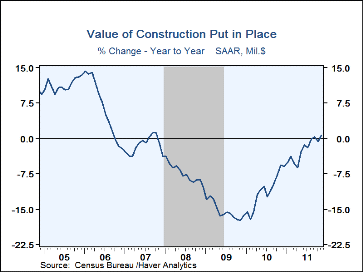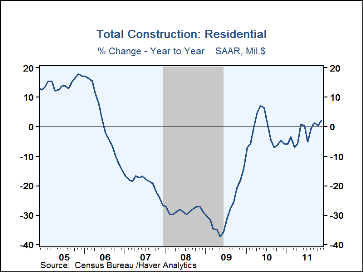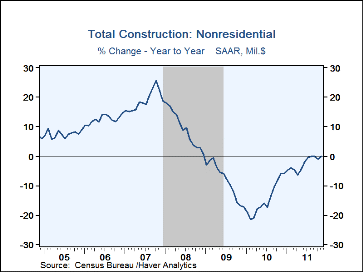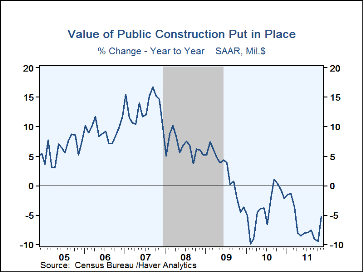 Global| Jan 03 2012
Global| Jan 03 2012U.S. Construction Spending Gain Is Better-Than-Expected
by:Tom Moeller
|in:Economy in Brief
Summary
The level of building activity continues to improve, moderately. Construction spending during November rose 1.2% following a 0.2% October slip, revised from the 0.8% gain reported initially. However, September's gain was revised [...]
The level of building activity continues to improve, moderately. Construction spending during November rose 1.2% following a 0.2% October slip, revised from the 0.8% gain reported initially. However, September's gain was revised sharply higher to 1.1%. Consensus expectations were for a 0.4% November gain. These m/m machinations left the level of activity at its highest since June, 2010.
Private sector spending rose a sharp 1.0% led by a 2.0% rise (3.4% y/y) rise in residential building. The value of home-improvements again led the increase with a 2.6% rise (4.1% y/y). The value of single-family building rose 1.5% (2.5% y/y) and multi-family building increased 1.3% (4.1% y/y). Nonresidential building activity was unchanged m/m (4.5% y/y) with the y/y strength led by a 12.6% rise in factory sector building, a 12.0% gain in commercial construction, a 10.0% gain in education and a 9.2% rise in transportation. Building in the lodging sector fell 20.5% y/y and health care fell 4.9% y/y.
Public construction activity rose 1.7% (-5.3% y/y) and reversed its October decline. Power facility building jumped by nearly one-quarter m/m (-5.1% y/y) while highways & streets construction rose 1.9% (-2.2% y/y). The value of building in the latter category is nearly one-third of the public construction total. The value of building in the educational sector rose 0.5% (2.8% y/y). Office building fell 12.4% y/y and water supply was off 10.8% y/y.
The construction put-in-place figures are available in Haver's USECON database. The expectations figure is contained in Haver's AS1REPNA database.
| Construction Put in Place (%) | Nov | Oct | Sep | Y/Y | 2010 | 2009 | 2008 |
|---|---|---|---|---|---|---|---|
| Total | 1.2 | -0.2 | 1.1 | 0.5 | -11.3 | -15.3 | -7.5 |
| Private | 1.0 | 0.7 | 1.5 | 4.0 | -15.2 | -22.4 | -12.2 |
| Residential | 2.0 | 2.3 | 1.5 | 3.4 | -2.9 | -29.9 | -29.0 |
| Nonresidential | 0.0 | -0.6 | 1.5 | 4.5 | -24.0 | -16.0 | 10.5 |
| Public | 1.7 | -1.8 | 0.4 | -5.3 | -3.9 | 2.1 | 6.6 |
Tom Moeller
AuthorMore in Author Profile »Prior to joining Haver Analytics in 2000, Mr. Moeller worked as the Economist at Chancellor Capital Management from 1985 to 1999. There, he developed comprehensive economic forecasts and interpreted economic data for equity and fixed income portfolio managers. Also at Chancellor, Mr. Moeller worked as an equity analyst and was responsible for researching and rating companies in the economically sensitive automobile and housing industries for investment in Chancellor’s equity portfolio. Prior to joining Chancellor, Mr. Moeller was an Economist at Citibank from 1979 to 1984. He also analyzed pricing behavior in the metals industry for the Council on Wage and Price Stability in Washington, D.C. In 1999, Mr. Moeller received the award for most accurate forecast from the Forecasters' Club of New York. From 1990 to 1992 he was President of the New York Association for Business Economists. Mr. Moeller earned an M.B.A. in Finance from Fordham University, where he graduated in 1987. He holds a Bachelor of Arts in Economics from George Washington University.










